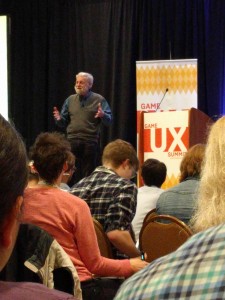
On May 12, the UX department had the pleasure of attending Epic Games’s inaugural Game UX Summit in Durham. It was a day-long event with speakers from academia to international video game companies to mobile gaming.
Chad and I were excited to attend and hear how another industry approaches user experience, which we were pleasantly surprised to find out doesn’t differ all that much from ux in libraries. Well apart from what’s being tested—video games instead of library tools.
One example of how ux for video games relates to ux for libraries came from Anders Johansson, Lead UI Designer for The Division by Massive Entertainment. Mr. Johansson and his team developed the map interface used in the game. Since the game has many points of interest, the original design created decision fatigue in players. He found that most users didn’t take advantage of normal filters. So Mr. Johansson looked beyond his industry and utilized a Google Maps feature to incorporate adaptable filters, which change based on zoom level.
Chad and I felt this example could be applied to the library’s catalog filters. With the new catalog system being discussed, we would like to test out some mockups on our users that show them different filters at different times depending on their search and previous filter selections.
The highlight of the day was hearing from 2 major UX players for the keynote addresses—Dan Ariely from The Center for Advanced Hindsight and Don Norman, co-founder of the Nielsen Norman Group. While Mr. Ariely talked about how to incentivize behavior change in users, Mr. Norman focused on the process of human centered design.
Both speakers emphasized UX’s bread and butter—the importance of building trust with users and stakeholders. As UX professionals, our bread and butter is building trust with our users and our stakeholders over time. We use our skills and methods to make data-driven decisions that benefit both sides.